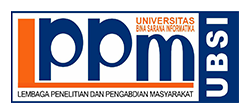Algoritma K-Means Untuk Klasterisasi Jabatan Fungsional Dosen Pada Perguruan Tinggi Swasta Di Lingkungan LLDikti Wilayah III
DOI:
https://doi.org/10.31294/paradigma.v24i1.1112Keywords:
Data mining, Clustering, Lecturer, Functional PositionAbstract
Permanent lecturers and lecturers who have functional positions absolutely must be owned by every university in Indonesia in order to fulfill the provisions of the legislation. Article 48 paragraph (2) of Law Number 14 of 2005 concerning Teachers and Lecturers states that the level of academic positions of permanent lecturers consists of asisten ahli, lektor, lektor kepala dan profesor. Lecturers still have to comply with these rules by submitting proposals for functional positions if they fulfill the qualification, in addition, universities where lecturers work must also proactively encourage lecturers to fulfill their obligations. Many lecturers from various universities, even though they have fulfill qualification, did not immediately take the initiative to propose their functional positions. In grouping the data for permanent lecturers and lecturers who have functional positions using data mining techniques, the k-means clustering method. The data is taken from the link https://pddikti.kemdikbud.go.id/. The results of this study are clusters of the number of permanent lecturers and lecturers who have functional positions into 3 clusters. There are 15 private universities (PTS) in the LLDikti III region with clusters of permanent lecturers and lecturers who have the most functional positions, then the medium level cluster is 45 private universities and the lowest cluster is 228 private universities.
References
Asroni dan Adrian, Ronal. (2015). Penerapan Metode K-Means Untuk Clustering Mahasiswa Berdasarkan Nilai Akademik Dengan Weka Interface Studi Kasus Pada Jurusan Teknik Informatika UMM Magelang. Jurnal Ilmiah Semesta Teknika 18(1) https://doi.org/10.18196/st.v18i1.708.
Angga Ginanjar Mabrur, L. R. (2012). Penerapan Data Mining Untuk Memprediksi Kriteria Nasabah Kredit. Jurnal Komputer Dan Informatika (KOMPUTA), 1(1), 53–57.
Darmi, Y., & Setiawan, A. (2016). Penerapan Metode Clustering K-Means Dalam Pengelompokan Penjualan Produk. Y. Darmi, A. Setiawan, 12(2), 148–157.
Kristanto, N. H., A, A. C. L., & S, H. B. (2016). Implemantasi K-Means Clustering untuk Pengelompokan Analisis Rasio Profitabilitas dalam Working Capital. Juisi, 02(01), 9–15.
Robani, M., & Widodo, A. (2016). Algoritma K-Means Clustering Untuk Pengelompokan Ayat Al Quran Pada Terjemahan Bahasa Indonesia. Jurnal Sistem Informasi Bisnis, 6(2), 164. https://doi.org/10.21456/vol6iss2pp164-176
Wakhidah, Nur, (2010) Clustering Menggunakan K-Means Algorithm (K-Means Algorithm Clustering). Jurnal Transformatika 8(1). http://dx.doi.org/10.26623/transformatika.v8i1.45
https://lldikti3.kemdikbud.go.id/
Downloads
Published
How to Cite
Issue
Section
License
Copyright (c) 2022 Noviyanto Novi, Prita Ekasari

This work is licensed under a Creative Commons Attribution-ShareAlike 4.0 International License.
Paradigma is an open-access article distributed under the terms of the Creative Commons Attribution-ShareAlike 4.0 International License (https://creativecommons.org/licenses/by-sa/4.0/) , This license permits: Share — copy and redistribute the material in any medium or format for any purpose, even commercially, Adapt — remix, transform, and build upon the material for any purpose, even commercially.




















 Jl. Kramat Raya No.98, Kwitang, Kec. Senen, Kota Jakarta Pusat, DKI Jakarta 10450
Jl. Kramat Raya No.98, Kwitang, Kec. Senen, Kota Jakarta Pusat, DKI Jakarta 10450
